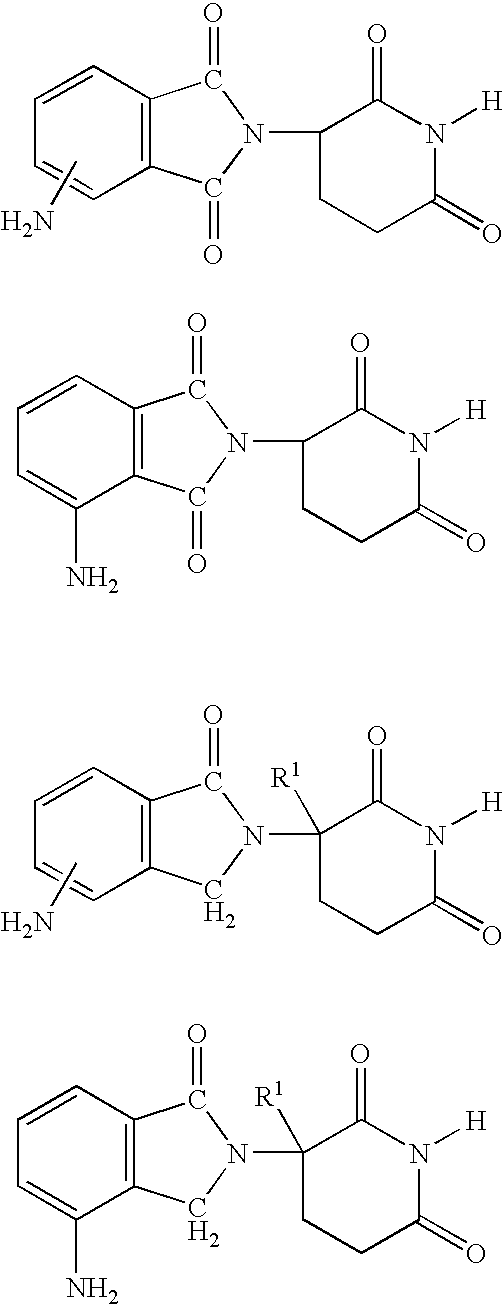Methods of using and compositions comprising immunomodulatory compounds for the treatment and management of myelodysplastic syndromes
a technology of immunomodulatory compounds and compositions, applied in the direction of immunological disorders, drug compositions, peptides, etc., can solve the problems of variable risk of progression to acute leukemia, ineffective blood cell production, morphology and maturation, etc., and achieve the effect of prolonging the tim
- Summary
- Abstract
- Description
- Claims
- Application Information
AI Technical Summary
Benefits of technology
Problems solved by technology
Method used
Image
Examples
first embodiment
[0030] the invention encompasses methods of treating or preventing MDS which comprise administering to a patient in need of such treatment or prevention a therapeutically or prophylactically effective amount of an immunomodulatory compound, or a pharmaceutically acceptable salt, solvate, hydrate, stereoisomer, clathrate, or prodrug thereof. The embodiment encompasses the treatment, prevention or management of specific sub-types of MDS such as refractory anemia, refractory anemia with ringed sideroblasts, refractory anemia with excess blasts, refractory anemia with excess blasts in transformation and chronic myelomonocytic leukemia.
[0031] As used herein, the term "myelodysplastic syndromes" or "MDS" means hematopoietic stem cell disorders characterized by one or more of the following: ineffective blood cell production, progressive cytopenias, risk of progression to acute leukemia or cellular marrow with impaired morphology and maturation (dysmyelopoiesis). The term "myelodysplastic s...
example 1
[0183] In a specific embodiment, prophylactic or therapeutic agents are administered in a cycle of about 16 weeks, about once or twice every day. One cycle can comprise the administration of a therapeutic on prophylactic agent and at least one (1), two (2), or three (3) weeks of rest. The number of cycles administered is from about 1 to about 12 cycles, more typically from about 2 to about 10 cycles, and more typically from about 2 to about 8 cycles.
example 2
[0184] The objectives of the study are to evaluate the efficacy and safety of oral administration of 3-(4-amino-1-oxo-1,3-dihydro-isoindol-2-yl)-pip-eridine-2,6-dione in patients with MDS. Patients receive the compound in an amount of 10 mg / d or 15 mg / d for 21 days every 28 days in 4-week cycles for 16 weeks (4 cycles) or 24 weeks (6 cycles). The subject population comprises patients with low- or interemediate-1-risk MDS (International Prognostic Scoring System) with red blood cell transfusion-dependent anemia who have received at least two units of RBCs within 8 week of baseline (first day of study treatment). In addition to hematological laboratory monitoring, bone marrow aspirates / biopsies with cytogenic analyses are obtained at baseline, after the completion of 3 cycles and after the completion of 6 cycles. The bone marrow, safety and efficacy data are reviewed to assess benefit-to-risk considerations throughout the study. The study reviews red blood cell transfusion independenc...
PUM
| Property | Measurement | Unit |
|---|---|---|
| weight percent | aaaaa | aaaaa |
| weight percent | aaaaa | aaaaa |
| weight percent | aaaaa | aaaaa |
Abstract
Description
Claims
Application Information
 Login to View More
Login to View More - R&D
- Intellectual Property
- Life Sciences
- Materials
- Tech Scout
- Unparalleled Data Quality
- Higher Quality Content
- 60% Fewer Hallucinations
Browse by: Latest US Patents, China's latest patents, Technical Efficacy Thesaurus, Application Domain, Technology Topic, Popular Technical Reports.
© 2025 PatSnap. All rights reserved.Legal|Privacy policy|Modern Slavery Act Transparency Statement|Sitemap|About US| Contact US: help@patsnap.com



